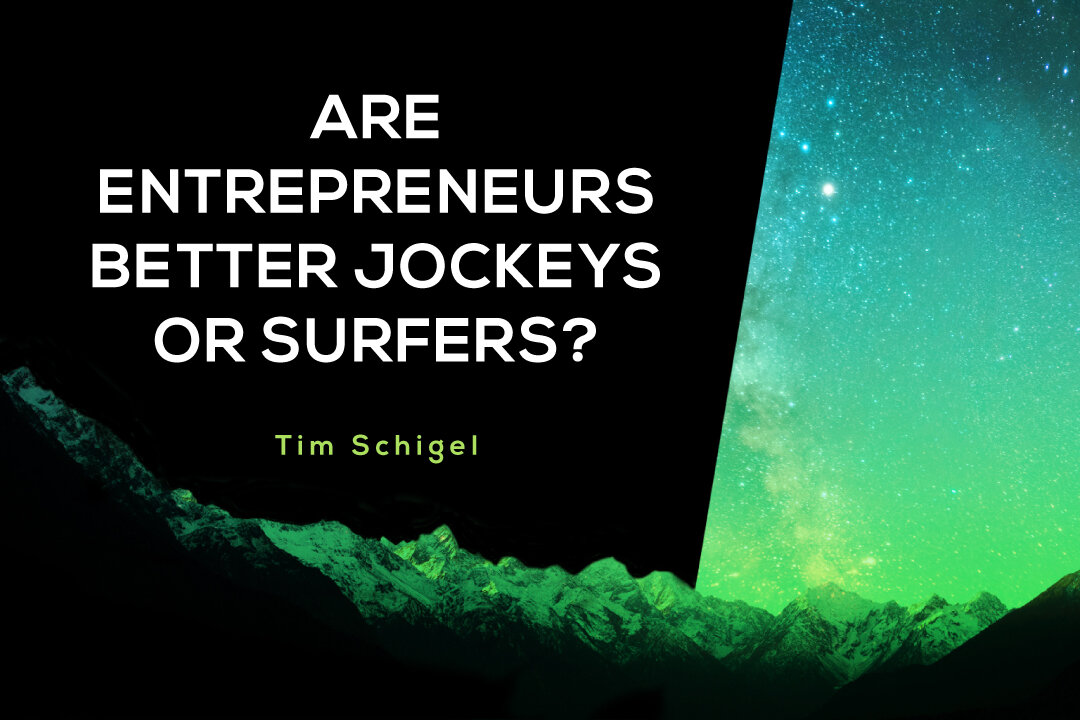You may have heard of the horse and jockey analogy used for investing—some people bet on the horse, i.e., the business or the business model, and others on the jockey, i.e., the CEO or the person who runs the company. But by doing this, they leave out the biggest factor—the market.
Instead of focusing on people or the business, investors and entrepreneurs should focus on broader economic efforts, which makes me think of the famous expression, “a rising tide lifts all boats.”
Given that the biggest factor is left out of the horse and jockey analogy, I prefer to use a surfer analogy.
If you ever watch surfers riding those intense, or in surfer speak, gnarly waves, you’ll notice one very obvious thing: they all wait for the waves and know exactly when to stand up to catch and ride the wave. If you’re a surfer, you know that timing is everything. It doesn’t matter how much you want to surf or how good your board is—if your timing is off, you will not catch those wicked waves.
When investing in a business, the same concept applies. Imagine that you are the surfer, the surfboard is the business or product, and the wave is the market. To successfully bring your company or product to market, you need to catch the wave at the right time.
Now, imagine that the ocean is the market and that a wave is a disruption in a market or a transition in the market. The bigger the wave, the bigger the market transition. And, if you happen to be a boat on that wave, you will get lifted. And if the boat is your business, whether your business is the best business in the world or not, it’s going to benefit from that rising market—if you’re on the right side of that market.
Many companies build a great company and have a good product and a brilliant team, but they are often ahead of the wave. They’ve gotten on the board too early, and as a result, they don’t get anywhere. “We just need to educate the market” is a common refrain. And they don’t look like a very good surfer at that point.
The better surfers—entrepreneurs and investors—know how to assess when the wave is coming, and they get on their boards at the right moment. Being an excellent surfer and having a fantastic board certainly also benefits them and may help them outperform those other people that are on the wave with lesser capabilities. But at the end of the day, they all win to some degree.
One venture firm, Sequoia Capital, understands this and I think we can learn a lot from them. They are one of the most prominent private equity and venture capital firms in the world, and they predominantly focus on technology and innovation. Sequoia is successful because they realize that it is better for companies to enter an existing market with a revolutionary solution rather than create a new market where they need to create a following from scratch.
Here are some things that I like about them:
- They work with markets, not people.
- They are more interested in how the idea will unfold in developing markets than in a person’s credentials and intelligence.
- They invest in future technologies and markets.
- By investing systematically, they work out which complementary tools and applications will work alongside initial upcoming technologies and markets and invest in these.
- They strive to be different, not better.
- They look for startups that identify problems in existing markets and use unconventional thinking to provide new solutions that change the behavior within those markets.
- They maximize top performers.
- They develop long-standing investments that last well over a decade, capitalizing on the growth of top-performing companies.
I think too many investors are either too infatuated with the solution or are in awe of the entrepreneur’s credentials. As a investor, you can’t just focus on the founder or the product – you need to understand the market to know if the timing is right.
The best leaders can see the waves years before they arrive. Think about Jeff Bezos, back when he founded Amazon in 1994, during the very early days of the internet. Back then, Bezos knew that people would be buying products from the internet. Those days were some of his most difficult because people didn’t know what the internet was.
Bezos said, “the first question most of those [investors] had was ‘what’s the internet?’” That means most people didn’t know what the internet was. But Bezos did, and he also knew people would buy products from the internet. That’s a great example of long-term vision.
According to the “12 Business Lessons You Can Learn from Amazon Founder and CEO Jeff Bezos,” Bezos also said, “me-too companies have not done that well over time.” The article expanded on this, “So you need to invent and be willing to be misunderstood. Because all disruptors are inventors. And me-too companies are not inventors.”
“The question we would always have before we would embark on such a thing is: What’s the idea? What would we do that would be different? How would it be better? We don’t want to just do things because we can do them … we don’t want to be redundant,” said Bezos.
Bezos is thinking three years ahead, and he and his staff are always working in the future. According to the article, Bezos has said that “Having this long-term thinking approach, helps businesses focus on planning and where they should invest their energy.”
After investing in many companies my experiences have shown that often the reasons for failures had nothing to do with the team or with the product—we were just early in the market. The wave hadn’t started yet.
I once invested in a company called Digital 5, which made streaming media software that was embedded in Netgear devices and Gateway DVD players. It was one of the first consumer electronics products that let you stream media from the internet in your home.
The devices that Digital 5 powered became one of the biggest consumer electronics products at the time. The only thing that (a lot) bigger was the iPod. We got a lot of attention at the CES conference, and we were distributed in Best Buy stores.
I remember myself and some of the board members doing some mystery shopping. We’d go into a Best Buy and ask for the streaming media player for the home. And the salespeople were always confused. They never knew which area to find it in. The home networking area? The sound and entertainment area? The Bluetooth area? They didn’t even know where it was in their own store.
The company was acquired in 2006. I remember being in a board meeting and saying: “You know what, it’s too early. It doesn’t matter how good our stuff is; consumers are just not ready for this yet. We’ll get early adopters, but we’re not going to get the big consumer market because it’s just too early.”
This is one of my failed investments that provided a lot of learning because we decided to sell the company and recognized that we didn’t know when the market was going to hit. We just didn’t know when the wave was going to come.
Another thing we learned from this is we should not make the founder, or the CEO, or the team feel bad about it. It helped us all become better leaders. Personally, it helped me make better decisions in future investments, like with Refinery. The COO at the time went on to become president of one of the most popular consumer products today.
So, even if you are the world’s best surfer and you’ve created the most aerodynamic, most amazing surfboard, if you go out into the water and get on your board before the wave comes, you just won’t get anywhere. So the lesson is – study the waves aka the market. Big waves don’t happen by surprise—you can see them coming. Learn how to read the data, study it, and you’ll be able to forecast and ride the gnarly waves.



